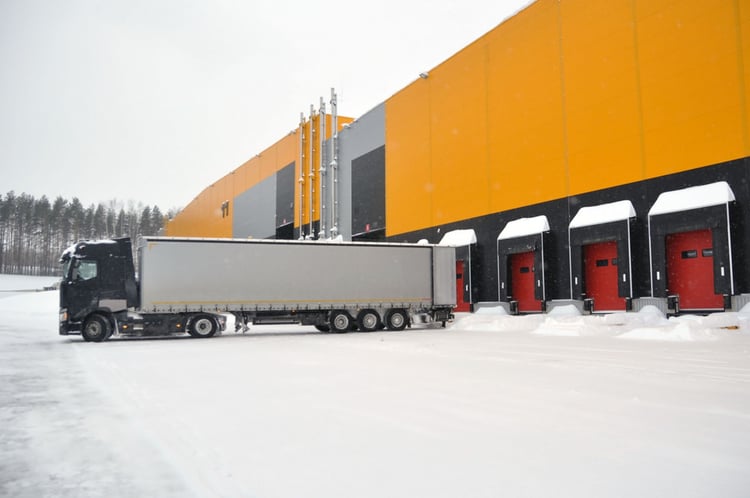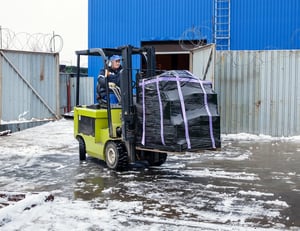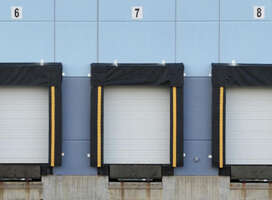
In the last several months of the year, your warehouse or distribution center is probably concerned about being ready for peak season. After all, holiday shopping begins ramping up in the fall and activity doesn’t slow down until well after the new year. But another concern for your business, depending on its location, should be the winter weather.
As the holidays approach, the temperatures will drop, and snow and freezing rain will begin to fall. While you can’t change the forecast, you can make sure your facility is ready to handle what Mother Nature has in store. Here is why this is a concern for warehouses and how your facility can get sufficiently prepped for winter.
Why Warehouses Are Affected By Winter
Warehouses are usually very large buildings with simple designs. They aren’t made to protect against heat or cold. Although it can be uncomfortable to work in hot conditions, more dangers exist, and damage can occur when there is extremely cold weather.
Worker Safety
 When it becomes too cold in the warehouse, this poses a safety issue for workers. Melted ice and snow can create wet and slippery conditions. Extreme cold can also lead to hypothermia and flu-like symptoms among workers.
When it becomes too cold in the warehouse, this poses a safety issue for workers. Melted ice and snow can create wet and slippery conditions. Extreme cold can also lead to hypothermia and flu-like symptoms among workers.
Risks to Equipment
Some equipment, like conveyors and robotics, aren’t meant to operate in extreme environments. It’s important to understand the limitations of your warehouse equipment so it doesn’t become damaged or deteriorate quickly.
Product Integrity
Depending on the types of products your warehouse or distribution center stores and fulfills, you need to understand how extreme temperatures can impact those items. If there are wet floors, this could damage boxes and the items inside.
Reduced Productivity
Studies have revealed that workers who are exposed to uncomfortable temperatures are likely to be less productive. More mistakes happen and less gets done. This isn’t something you want happening during the busiest time of the year for your business.
How to Properly Prep Your Warehouse for the Winter Months
With so much to keep track of during peak season, it can be challenging to make sure your facilities are ready to take on extreme weather conditions. But it’s an important part of doing business and ensuring a positive customer and employee experience. Here are some tips for properly prepping your warehouse or distribution center for the winter months.
1. Check Door Seals and Windows
During extreme weather conditions, you want to keep as much cold air and precipitation as possible outside your warehouse. You can do this by checking your door seals and windows. These will also help your HVAC system work more efficiently.
2. Tuneup Your HVAC System
 Don’t wait until it gets uncomfortably cold to figure out if your heat is going to work. Have your HVAC system serviced several times each year — before the summer heat arrives and leading up to winter. This can prevent unexpected outages during peak season.
Don’t wait until it gets uncomfortably cold to figure out if your heat is going to work. Have your HVAC system serviced several times each year — before the summer heat arrives and leading up to winter. This can prevent unexpected outages during peak season.
3. Service Water Tanks and Air Compressors
Set aside some time to service your facility’s water tanks and air compressors. During extremely low temperatures, this equipment can suffer from condensation buildup and breakdown. If properly serviced and insulated, they should continue to work throughout the season.
4. Ensure Your Lighting Is Sufficient
All warehouses need some type of lighting since they are indoors. But the winter months tend to be darker overall, so it’s a good idea to reevaluate your lighting conditions. Make sure the inside and outside of your facility are well-lit to allow for productive work and to prevent injuries.
5. Thoroughly Clean Your Facility
Before you have a major weather event with cold and wet conditions, it’s a good idea to thoroughly clean your facility. You’ll want to do this anyway heading into peak season so you can be as organized and productive as possible.
6. Verify Proper Drainage
When you clean your facility, you can also check all internal and external drains to ensure they’re working properly. The last thing you want is puddles of melted ice or snow accumulating as you’re trying to get orders fulfilled.
7. Arrange for Snow and Ice Removal
If you’re going to get snow and ice, you need to have arrangements in place to remove it as soon as possible. If you rent your space, contact the landlord or property management company for a referral. Otherwise, you might consider having the equipment on hand to do this yourself.
8. Prepare Slip Prevention Measures
Slip and fall accidents are the most common warehouse workplace accidents, which is frustrating because they are entirely preventable. Your warehouse should install rubber or textured mats at entrances to prevent water from entering the building. Textured floor coatings can also help prevent these accidents.
9. Provide Adequate PPE
Your warehouse workers should always have access to appropriate personal protective equipment (PPE), depending on their job duties. This may need to be adjusted to take into account the winter conditions. For example, larger sizes of reflective vests would be necessary to fit over warm clothing. And non-slip gloves may need to be lined so they are warm.
10. Protect Your Inventory
It’s essential to consider what conditions your products should be stored in so they don’t get damaged or spoiled by the cold. Take into account the type of space you have, what temperature and humidity levels are optimal, and what the most extreme weather might look like.
There are many things you’ll want to address when it comes to the colder months. It’s essential to ensure your warehouse or distribution center is prepared so your workers, products, equipment, business partners, and customers don’t pay the price in the end.












